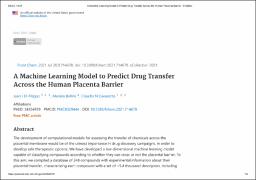| dc.contributor.author | Di Filippo, Juan. | |
| dc.contributor.author | Bollini, Mariela. | |
| dc.contributor.author | Cavasotto, Claudio. | |
| dc.date.accessioned | 2023-05-08T17:08:53Z | |
| dc.date.available | 2023-05-08T17:08:53Z | |
| dc.date.issued | 2021-07-01 | |
| dc.identifier.citation | Front Chem . 2021 Jul 20;9:714678. | es |
| dc.identifier.issn | 2296-2646 | |
| dc.identifier.uri | https://riu.austral.edu.ar/handle/123456789/2133 | |
| dc.identifier.uri | https://www.frontiersin.org/articles/10.3389/fchem.2021.714678/full | |
| dc.description | Disponible en: https://www.frontiersin.org/articles/10.3389/fchem.2021.714678/full | es |
| dc.description.abstract | Abstract
The development of computational models for assessing the transfer of chemicals across the placental membrane would be of the utmost importance in drug discovery campaigns, in order to develop safe therapeutic options. We have developed a low-dimensional machine learning model capable of classifying compounds according to whether they can cross or not the placental barrier. To this aim, we compiled a database of 248 compounds with experimental information about their placental transfer, characterizing each compound with a set of ∼5.4 thousand descriptors, including physicochemical properties and structural features. We evaluated different machine learning classifiers and implemented a genetic algorithm, in a five cross validation scheme, to perform feature selection. The optimization was guided towards models displaying a low number of false positives (molecules that actually cross the placental barrier, but are predicted as not crossing it). A Linear Discriminant Analysis model trained with only four structural features resulted to be robust for this task, exhibiting only one false positive case across all testing folds. This model is expected to be useful in predicting placental drug transfer during pregnancy, and thus could be used as a filter for chemical libraries in virtual screening campaigns.
Keywords: clearence index; fetus:mother ratio; machine learning; placenta barrier permeability; toxicology.
Copyright © 2021 Di Filippo, Bollini and Cavasotto. | es |
| dc.language.iso | en | es |
| dc.publisher | Frontiers Media | es |
| dc.rights | Attribution-NonCommercial-NoDerivatives 4.0 Internacional | * |
| dc.rights.uri | http://creativecommons.org/licenses/by-nc-nd/4.0/ | * |
| dc.subject | Clearence index. | es |
| dc.subject | Fetus. | es |
| dc.subject | Machine learning. | es |
| dc.title | A Machine Learning Model to Predict Drug Transfer Across the Human Placenta Barrier | es |
| dc.type | Article | es |


